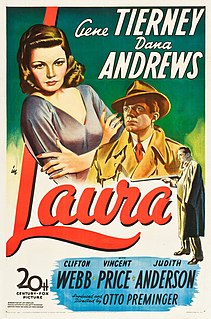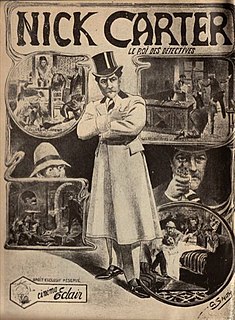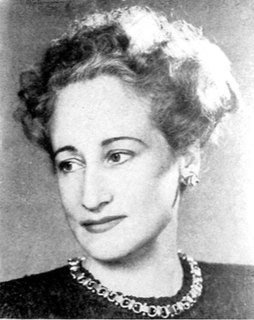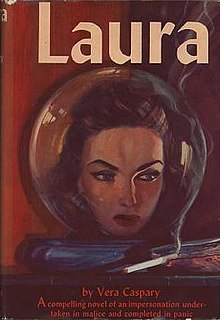Detective fiction is a subgenre of crime fiction and mystery fiction in which an investigator or a detective—either professional, amateur or retired—investigates a crime, often murder. The detective genre began around the same time as speculative fiction and other genre fiction in the mid-nineteenth century and has remained extremely popular, particularly in novels. Some of the most famous heroes of detective fiction include C. Auguste Dupin, Sherlock Holmes, and Hercule Poirot. Juvenile stories featuring The Hardy Boys, Nancy Drew, and The Boxcar Children have also remained in print for several decades.

Laura is a 1944 American film noir produced and directed by Otto Preminger. It stars Gene Tierney, Dana Andrews, and Clifton Webb along with Vincent Price and Judith Anderson. The screenplay by Jay Dratler, Samuel Hoffenstein, and Betty Reinhardt is based on the 1943 novel Laura by Vera Caspary.

Crime fiction, detective story, murder mystery, mystery novel, and police novel are terms used to describe narratives that centre on criminal acts and especially on the investigation, either by an amateur or a professional detective, of a serious crime, generally a murder. It is usually distinguished from mainstream fiction and other genres such as historical fiction or science fiction, but the boundaries are indistinct. Crime fiction has multiple sub-genres, including detective fiction, courtroom drama, hard-boiled fiction, and legal thrillers. Most crime drama focuses on crime investigation and does not feature the court room. Suspense and mystery are key elements that are nearly ubiquitous to the genre.

Mystery is a fiction genre where the nature of an event, usually a murder or other crime, remains mysterious until the end of the story. Often within a closed circle of suspects, each suspect is usually provided with a credible motive and a reasonable opportunity for committing the crime. The central character is often a detective (such as Sherlock Holmes, who eventually solves the mystery by logical deduction from facts presented to the reader. Some mystery books are non-fiction. Mystery fiction can be detective stories in which the emphasis is on the puzzle or suspense element and its logical solution such as a whodunit. Mystery fiction can be contrasted with hardboiled detective stories, which focus on action and gritty realism.
Crime is a typically 19th-, 20th- and 21st-century genre, dominated by British and American writers. This article explores its historical development as a genre.

A mystery film is a genre of film that revolves around the solution of a problem or a crime. It focuses on the efforts of the detective, private investigator or amateur sleuth to solve the mysterious circumstances of an issue by means of clues, investigation, and clever deduction.

Hardboiled fiction is a literary genre that shares some of its characters and settings with crime fiction. The genre's typical protagonist is a detective who battles the violence of organized crime that flourished during Prohibition (1920–1933) and its aftermath, while dealing with a legal system that has become as corrupt as the organized crime itself. Rendered cynical by this cycle of violence, the detectives of hardboiled fiction are often antiheroes. Notable hardboiled detectives include Philip Marlowe, Mike Hammer, Sam Spade, Lew Archer, Slam Bradley, and The Continental Op.

Evil Under the Sun is a work of detective fiction by British writer Agatha Christie, first published in the UK by the Collins Crime Club in June 1941 and in the US by Dodd, Mead and Company in October of the same year. The UK edition retailed at seven shillings and sixpence (7/6) and the US edition at $2.00.

Where the Sidewalk Ends is a 1950 American film noir directed and produced by Otto Preminger. The screenplay for the film was written by Ben Hecht, and adapted by Robert E. Kent, Frank P. Rosenberg, and Victor Trivas. The screenplay and adaptations were based on the novel Night Cry by William L. Stuart. The film stars Dana Andrews and Gene Tierney.

Vera Louise Caspary was an American writer of novels, plays, screenplays, and short stories. Her best-known novel, Laura, was made into a highly successful movie. Though she claimed she was not a "real" mystery writer, her novels effectively merged women's quest for identity and love with murder plots. Independence is the key to her protagonists, with her novels revolving around women who are menaced, but who turn out to be neither victimized nor rescued damsels.

Night Train (1997) is a comedic parody of American detective novels by author Martin Amis, named after the song "Night Train," which features twice in the novel.
Dorothy B. Hughes was an American crime writer, literary critic, and historian. Hughes wrote fourteen crime and detective novels, primarily in the hardboiled and noir styles, and is best known for the novels In a Lonely Place (1947) and Ride the Pink Horse (1946).
Mignon Good Eberhart was an American author of mystery novels. She had one of the longest careers among major American mystery writers.
Elisabeth Sanxay Holding (1889–1955) was an American novelist and short story writer. She primarily authored fiction in the hardboiled subgenre of detective novels.
Cozy mysteries, also referred to as "cozies", are a subgenre of crime fiction in which sex and violence occur off stage, the detective is an amateur sleuth, and the crime and detection take place in a small, socially intimate community. Cozies thus stand in contrast to hardboiled fiction, which features violence and sexuality more explicitly and centrally to the plot. The term "cozy" was first coined in the late 20th century when various writers produced work in an attempt to re-create the Golden Age of Detective Fiction.

The Lodger is a novel by English author Marie Adelaide Belloc Lowndes. The short story was first published in the last edition of McClure's Magazine, in 1911. Belloc Lowndes wrote a longer version of the story, which was published as a series in the Daily Telegraph in 1913 with the same name. Later that year, the novel was published in its entirety by Methuen Publishing.

Bedelia is a 1946 British drama film directed by Lance Comfort and starring Margaret Lockwood, Ian Hunter and Barry K. Barnes. It is an adaptation of the 1945 novel Bedelia by Vera Caspary with events moved from the United States to England and Monaco.

Wildfire at Midnight is a novel by Mary Stewart which was first published in 1956. Stewart herself described the book as "an attempt at something different, the classic closed-room detective story with restricted action, a biggish cast, and a closely circular plot".
Laura is a 1968 American TV film, a remake of the 1944 film of the same name. It was directed by John Llewellyn Moxey and written by Truman Capote and Thomas Phipps. David Susskind produced.
Laura is a 1955 American TV film for The 20th Century-Fox Hour. It was a remake of the 1944 film of the same name.












